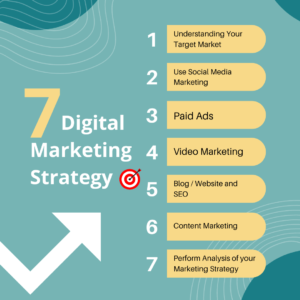
Creating and sharing valuable content, such as blog posts, videos, and infographics, to attract and engage a target audience.
Scope of Digital Marketing
Digital marketing’s scope covers a broad array of strategies and techniques designed to leverage online platforms for reaching and engaging audiences.
Techniques
1. Search Engine Optimization (SEO)
-
Keyword Research:
Identifying relevant keywords and phrases your target audience searches for.
-
On-Page SEO:
Optimizing content, meta titles, descriptions, headers, and images for targeted keywords.
-
Technical SEO:
Improving website infrastructure, such as page speed, mobile-friendliness, and site architecture.
-
Off-Page SEO:
Building backlinks from reputable sites to enhance domain authority.
2. Content Marketing
-
Blogging:
Creating and publishing informative, valuable articles that address your audience’s interests or pain points.
-
Video Marketing:
Producing engaging videos for platforms like YouTube, social media, or your website.
-
Infographics:
Designing visual content that simplifies complex information and attracts attention.
-
E-books and Whitepapers:
Offering in-depth content on specific topics to generate leads and demonstrate expertise.
3. Social Media Marketing
-
Profile Optimization:
Ensuring that social media profiles are complete, branded, and optimized for search.
-
Content Creation:
Sharing relevant posts, images, and updates tailored to each platform.
-
Social Media Ads:
Running targeted advertising campaigns on platforms like Facebook, Instagram, and LinkedIn.
-
Community Engagement:
Interacting with followers, responding to comments, and participating in discussions.
4. Email Marketing
-
Newsletter Campaigns:
Sending regular updates, news, and promotions to subscribers.
-
Automated Drip Campaigns:
Setting up automated sequences to nurture leads and engage customers based on their behavior.
-
Segmentation:
Dividing email lists into segments to send personalized and relevant messages.
-
A/B Testing:
Testing different email elements (subject lines, content, calls to action) to optimize performance.
5. Pay-Per-Click (PPC) Advertising
-
Search Ads:
Creating text ads that appear in search engine results for targeted keywords.
-
Display Ads:
Designing banner ads that appear on websites across the Google Display Network or other ad networks.
-
Social Media Ads:
Running targeted ads on social media platforms such as Facebook, Instagram, and LinkedIn.
-
Retargeting:
Displaying ads to users who have previously visited your website or interacted with your content.
6. Affiliate Marketing
-
Program Setup:
Establishing an affiliate program to partner with affiliates who promote your products.
-
Tracking and Management:
Using affiliate tracking software to monitor performance and manage relationships.
-
Commission Structures:
Offering commissions based on sales, leads, or clicks generated by affiliates.
7. Influencer Marketing
-
Influencer Identification:
Finding influencers whose audience aligns with your target market.
-
Collaboration:
Working with influencers to create sponsored posts, reviews, or other content.
-
Campaign Tracking:
Measuring the impact of influencer partnerships on brand awareness and sales.
